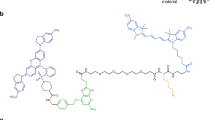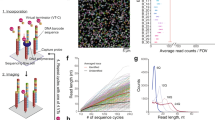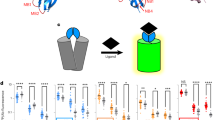Abstract
We report an approach to barcode cells through cell-surface expression of programmable zinc-finger DNA-binding domains (surface zinc fingers, sZFs). We show that sZFs enable sequence-specific labeling of living cells by dsDNA, and we develop a sequential labeling approach to image more than three cell types in mixed populations using three fluorophores. We demonstrate the versatility of sZFs through applications in which they serve as surrogate reporters, function as selective cell capture reagents and facilitate targeted cellular delivery of viruses.
This is a preview of subscription content, access via your institution
Access options
Subscribe to this journal
Receive 12 print issues and online access
$259.00 per year
only $21.58 per issue
Buy this article
- Purchase on Springer Link
- Instant access to full article PDF
Prices may be subject to local taxes which are calculated during checkout



Similar content being viewed by others
References
McMahon, M.A., Rahdar, M. & Porteus, M. Nat. Methods 9, 28–31 (2011).
Kim, Y.G., Cha, J. & Chandrasegaran, S. Proc. Natl. Acad. Sci. USA 93, 1156–1160 (1996).
Rebar, E.J. & Pabo, C.O. Science 263, 671–673 (1994).
Volná, P. et al. Nucleic Acids Res. 35, 2748–2758 (2007).
Barbas, C.F. III. US patent 2007/0178499 A1 (2007).
Chesnut, J.D. et al. J. Immunol. Methods 193, 17–27 (1996).
Brown, R.S. Curr. Opin. Struct. Biol. 15, 94–98 (2005).
Maeder, M.L. et al. Mol. Cell 31, 294–301 (2008).
Pattanayak, V., Ramirez, C.L., Joung, J.K. & Liu, D.R. Nat. Methods 8, 765–770 (2011).
Boch, J. et al. Science 326, 1509–1512 (2009).
Moscou, M.J. & Bogdanove, A.J. Science 326, 1501 (2009).
Duose, D.Y. et al. Nucleic Acids Res. 40, 3289–3298 (2012).
Lei, Y., Joo, K.I., Zarzar, J., Wong, C. & Wang, P. Virol. J. 7, 35 (2010).
Bendall, S.C. et al. Science 332, 687–696 (2011).
Livet, J. et al. Nature 450, 56–62 (2007).
Purnick, P.E. & Weiss, R. Nat. Rev. Mol. Cell Biol. 10, 410–422 (2009).
Boyce, M. & Bertozzi, C.R. Nat. Methods 8, 638–642 (2011).
Gartner, Z.J. & Bertozzi, C.R. Proc. Natl. Acad. Sci. USA 106, 4606–4610 (2009).
Delebecque, C.J., Lindner, A.B., Silver, P.A. & Aldaye, F.A. Science 333, 470–474 (2011).
Dueber, J.E. et al. Nat. Biotechnol. 27, 753–759 (2009).
Acknowledgements
This work was supported by US National Human Genome Research Institute grant P50 HG005550. SINmu plasmid for lentivirus experiments was a gift from P. Wang (University of Southern California).
Author information
Authors and Affiliations
Contributions
P.M. and G.M.C. conceived the study and designed the experiments. P.M. performed experiments. J.-H.L., D.L. and L.N. developed reagents. J.A. developed the image analysis suite and performed associated analyses. P.M., J.A. and G.M.C. wrote the manuscript with support from all authors.
Corresponding author
Ethics declarations
Competing interests
The authors declare no competing financial interests.
Supplementary information
Supplementary Text and Figures
Supplementary Figures 1–15, Supplementary Tables 1–4 and Supplementary Notes 1–3 (PDF 7215 kb)
Rights and permissions
About this article
Cite this article
Mali, P., Aach, J., Lee, JH. et al. Barcoding cells using cell-surface programmable DNA-binding domains. Nat Methods 10, 403–406 (2013). https://doi.org/10.1038/nmeth.2407
Received:
Accepted:
Published:
Issue Date:
DOI: https://doi.org/10.1038/nmeth.2407
This article is cited by
-
Decorating bacteria with self-assembled synthetic receptors
Nature Communications (2020)
-
Oligonucleotide conjugated multi-functional adeno-associated viruses
Scientific Reports (2018)
-
Therapeutic genome editing: prospects and challenges
Nature Medicine (2015)
-
Inner-outer beauty: DNA-binding surface tags as cellular barcodes
Nature Methods (2013)
-
Cas9 as a versatile tool for engineering biology
Nature Methods (2013)



